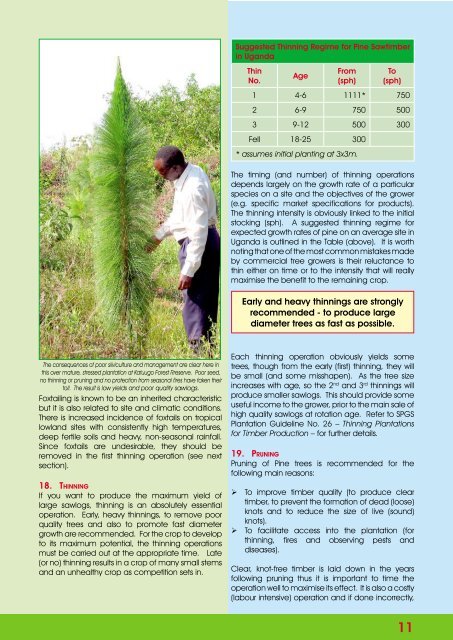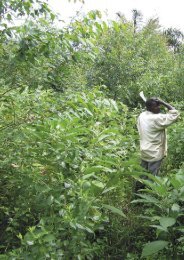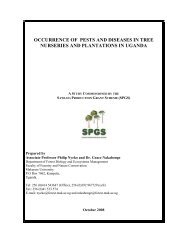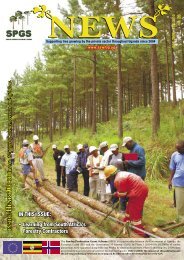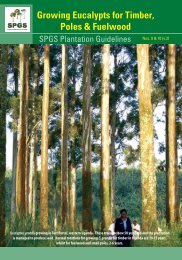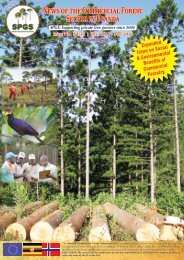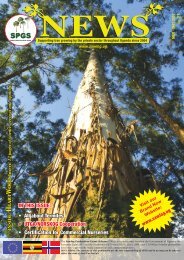Guideline No.12 - Gr.. - SPGS
Guideline No.12 - Gr.. - SPGS
Guideline No.12 - Gr.. - SPGS
You also want an ePaper? Increase the reach of your titles
YUMPU automatically turns print PDFs into web optimized ePapers that Google loves.
Suggested Thinning Regime for Pine Sawtimberin UgandaThinNo.AgeFrom(sph)To(sph)1 4-6 1111* 7502 6-9 750 5003 9-12 500 300Fell 18-25 300* assumes initial planting at 3x3m.The timing (and number) of thinning operationsdepends largely on the growth rate of a particularspecies on a site and the objectives of the grower(e.g. specific market specifications for products).The thinning intensity is obviously linked to the initialstocking (sph). A suggested thinning regime forexpected growth rates of pine on an average site inUganda is outlined in the Table (above). It is worthnoting that one of the most common mistakes madeby commercial tree growers is their reluctance tothin either on time or to the intensity that will reallymaximise the benefit to the remaining crop.Early and heavy thinnings are stronglyrecommended - to produce largediameter trees as fast as possible.The consequences of poor silviculture and management are clear here inthis over mature, stressed plantation at Katuugo Forest Rreserve. Poor seed,no thinning or pruning and no protection from seasonal fires have taken theirtoll. The result is low yields and poor quality sawlogs.Foxtailing is known to be an inherited characteristicbut it is also related to site and climatic conditions.There is increased incidence of foxtails on tropicallowland sites with consistently high temperatures,deep fertile soils and heavy, non-seasonal rainfall.Since foxtails are undesirable, they should beremoved in the first thinning operation (see nextsection).18. ThinningIf you want to produce the maximum yield oflarge sawlogs, thinning is an absolutely essentialoperation. Early, heavy thinnings, to remove poorquality trees and also to promote fast diametergrowth are recommended. For the crop to developto its maximum potential, the thinning operationsmust be carried out at the appropriate time. Late(or no) thinning results in a crop of many small stemsand an unhealthy crop as competition sets in.Each thinning operation obviously yields sometrees, though from the early (first) thinning, they willbe small (and some misshapen). As the tree sizeincreases with age, so the 2 nd and 3 rd thinnings willproduce smaller sawlogs. This should provide someuseful income to the grower, prior to the main sale ofhigh quality sawlogs at rotation age. Refer to <strong>SPGS</strong>Plantation <strong>Guideline</strong> No. 26 – Thinning Plantationsfor Timber Production – for further details.19. PruningPruning of Pine trees is recommended for thefollowing main reasons:‣ To improve timber quality (to produce cleartimber, to prevent the formation of dead (loose)knots and to reduce the size of live (sound)knots).‣ To facilitate access into the plantation (forthinning, fires and observing pests anddiseases).Clear, knot-free timber is laid down in the yearsfollowing pruning thus it is important to time theoperation well to maximise its effect. It is also a costly(labour intensive) operation and if done incorrectly,11


